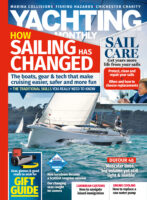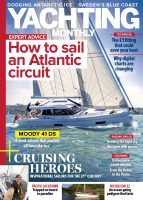Top-quality boat building with designs refined over years makes the Estonian-built Saare 41.2 one of the best cruisers you will ever sail, according to Theo Stocker
Saare 41.2 review: ‘One of the best cruisers you will ever sail’
You could be forgiven for not having heard of Saare Yachts. After all, they only build half a dozen or so yachts a year, in just three sizes – 38ft, 41ft and 47ft – but for anyone who has ever thought, ‘They don’t build boats like they used to,’ then the Saare 41.2 might be the boat for you.
These boats are built properly. Far from being stolidly heavy, however, Saare use some of latest construction techniques including vacuum infusion throughout and honeycomb-cored joinery to keep weight down, whilst still hand-built by craftsman who learned their trade from the centuries-old boat-building tradition on the Estonian island of Saaremaa, where a surprising number of other brands have their boats built and the University of Tallinn has its naval architecture facility.
As the Estonian republic emerged from the Soviet Union in 1991, some enterprising locals, in conjunction with Swedish investment, took over a large shed and established a boatyard before taking on the construction of Finngulf yachts in 1997, eventually completing over 220 Finngulf yachts from 28ft to 46ft, all designed by Karl-Johan Stråhlmann.
After Stig Nordblad sold Finngulf in 2007, he and yard manager Peeter Sääsk decided to start a new brand and commissioned a 41ft centre cockpit cruiser to be drawn again by Stråhlmann. This became the Saare 41cc, which remains in production, and of which the Saare 41.2 is a third-generation update, following on from the first 41 aft-cockpit in 2010.
When the Estonian owners wanted to sell the company, it was their dealers in north Germany, the Nielsen family of Yachtsport Eckernförde, who became custodians of the brand, while production continues at the Estonian yard uninterrupted. Saare Yachts has little interest in rapid expansion, high volume output or the latest fads – timeless appeal and doing things properly for the long term is far more valuable to them.
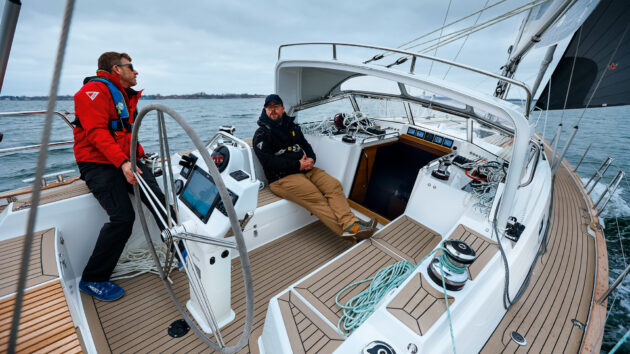
High coamings, a protective arch and windscreen, and enclosed transom make this a secure cockpit. Photo: Paul Wyeth
So why test a boat whose hull was drawn over 15 years ago? Well, the aft-cockpit Saare 41.2 is a significant evolution of the preceding versions and offers an alluring combination of time-proven hull form, beautiful craftsmanship and modern technology.
A weight saving of over half a tonne from vacuum infusion, a move to all vinylester resin, vacuum-bonded laminate Epex sails from Elvstrom, lithium batteries, induction cooking and touch-button sail handling and manouevring are among the innovations built into this model.
The ‘2’ in Saare 41.2 also denotes the fact that this boat has been configured for a crew of two, in recognition of the fact that most cruising couples sail double-handed these days.
Key changes to achieve this include the enlargement of a big bow locker for furling offwind sails, pushing the forward owner’s cabin aft for a larger, wider, berth; the introuction of 24V power systems to facilitate powered winches, bow and stern thrusters and induction cooking; a targa arch and optional solid doghouse for better protection in the cockpit as well as better sheeting angles, and an adapted layout below, ditching a third cabin in favour of a technical room, with the option of having just one cabin, and two stowage and technical cabins.
If you know it’s just going to be the two of you on your big adventures, this makes a huge amount of sense.

This code zero was borrowed for this test and was on the small side. Photo: Paul Wyeth
Waiting in comfort
The morning of our test dawned grey and windless.
It didn’t augur well for a meaningful test on the water, so we went below, put the heating and the kettle on coffee while Niels Nielsen explained the intricacies of the power system on board. He didn’t have long, as an induction hob boils a kettle much faster than gas, without any risk of blowing yourself up.
So to the power. There is a standard AGM start battery for the 50hp Volvo engine, but the main battery bank is 14.4kWh of three Victron lithium batteries, offering 600Ah at 24V (equivalent to 1,200 at 12V, or 2,400Ah of lead acid batteries).
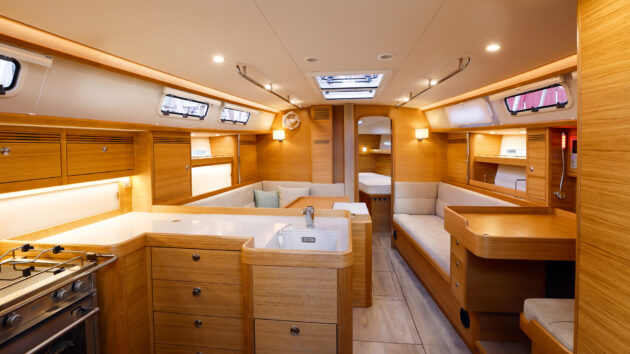
196cm headroom is a decent height. Photo: Paul Wyeth
The system is 24V because it is much easier to power winches, thrusters and windlass with much less voltage drop, thinner cables and more oomph on the higher voltage, and it’s still well within a safe voltage for the average DIY owner to work with.
This is all controlled and charged by a Victron system of chargers, transformers and battery management systems, monitored through the smart screen at the chart table, which also displays what power is going where, tank levels, fridge temperatures, and anything else tech-related on board.
The whole lot is protected by a galvanically-isolating transformer, so stray current from other boats on shore power isn’t going to fry your electrics and fittings. Other systems include 6kW diesel air heating, air-conditioning, retractable bow and stern thrusters and even a washing machine in the technical room, as well as all the usual electronics and autopilot (all Raymarine).
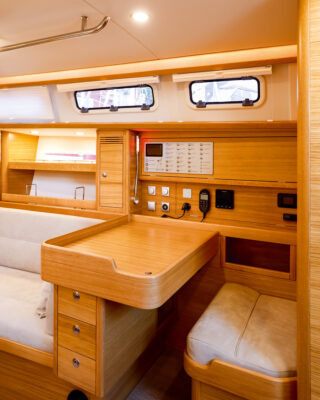
A proper chart table is surrounded by stowage and access to the electrical distribution and electronics is excellent. Photo: Paul Wyeth
Attention to detail
The quality of the boat’s build could be seen in little details, like the fact that through-hull fittings have been kept to a minimum. There’s only one seawater intake, other than for the engine through the sail drive, and this splits water to the heads intake, the foot-pump tap in the kitchen (this can be switched between fresh or sea water), and the air-conditioning, with just two outlet seacocks for the two sinks in the heads and galley and one more for the holding tank.
Bilge pumps (of which there are three on board, one manual, one small electric and one high capacity emergency electric), as well as shower and washing machine are taken out through a dedicated greywater outlet above the waterline at the stern. Everything has been fitted in immaculate order and care has been taken to ensure easy access to all systems throughout.
As for the layout, this is both luxuriously comfortable and practically seaworthy. The forward berth is huge, 210cm long by 225cm wide at the aft end (120cm at the forward end), with space to sit up at either end of the bed, with reading lights at both.
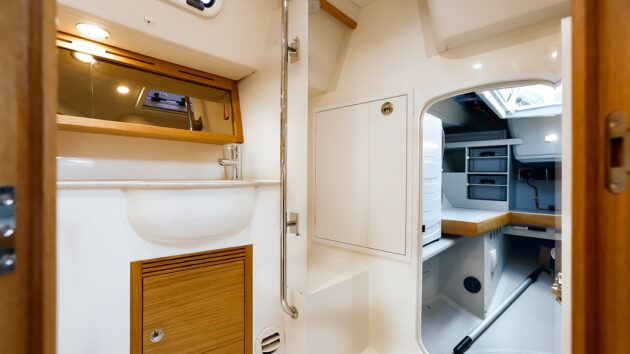
Access to the technical room and washing machine is aft of the heads. Photo: Paul Wyeth
From here you can enjoy views out of the hull windows, with two opening hatches and two opening windows in the coachroof. Storage abounds in shelves and over-bed lockers, as well as four upright lockers and up to six drawers. The space under the bunk is taken up with drawers, additional tanks for water and diesel if you opt for them, and at the forward end, the retractable bow thruster.
The slender hull form means it is not an island berth if that’s what you’re after, but it’s more than enough to be very comfortable for long periods on board. An ensuite heads is an option, but you would lose a chunk of the stowage and standing room.
The saloon, with L-shaped settee and table to port, and straight settee to starboard is beautifully finished – options are for light European oak or khaya mahogany, in either vertical or horizontal grain, and you can have the table however you like – it’s hand built after all.
This owner has opted for a second fridge in the central column of the table and an up-and-over folding table, though fold-down wings are possible too. Illuminated drinks cabinets are outboard to port, and in the forward end of the galley unit while lockers line the hull sides, with space for a proper ship’s library to starboard.
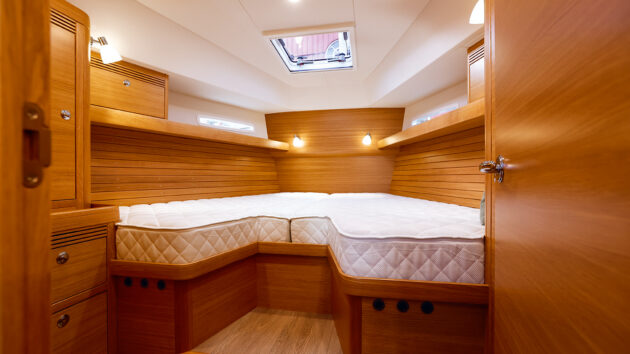
The boat’s slim hull shape means this isn’t an island bed, but at 225cm at the aft end, it is luxuriously wide. Photo: Paul Wyeth
Substantial chart table
The galley is huge – the J-shaped return putting the sink (here a single, but 1.5 also possible) on the centreline, with large a worksurface area above the drawers, and a large, top-opening, fridge outboard (water-cooled through the sink seacock heat exchanger). Aft of this is the reassuringly expensive GN Espace Levante two-hob induction oven. Other stowage in the form of lockers and drawers abounds.
Opposite this is the chart table, a proper, forward- facing unit with enough space for a full-size chart folded in half and more than enough space for a number of leisure folios inside it. Little details like the flush hinges mean you can use the full depth of this table.
Next to this are cubby holes, under-seat stowage and a column of drawers, as well as the switch panel. This and the panel below it fold out to give easy access to all the electronics and electrical distribution, which is neatly labelled and managed.
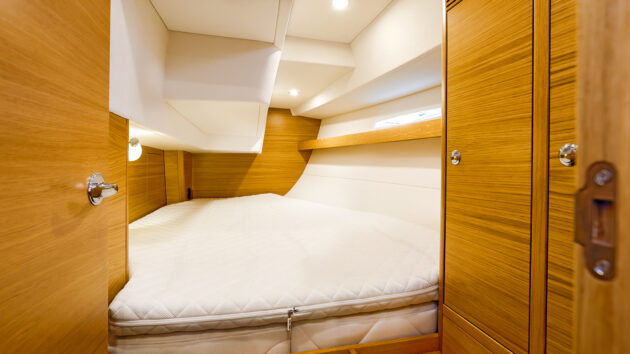
The aft berth is adequate, but the narrower transom is most noticable here. Photo: Paul Wyeth
Because there’s only one heads on board, it has been given ample space, with aft-facing toilet and a showering area with fold-out screen, although the floor is all one drained area so would be wet after showering.
At the aft end of the shower is the door hiding the washing machine, and access to the technical room. It doesn’t offer standing headroom, but you can comfortably sit on the work bench, from where you can get to the euro-box drawers, steering quadrant and autopilots, electric winch motors, and hatches into the electrical distribution space and the aft end of the engine space.
It’s rather snug with the calorifier in there, but all neat and easily accessible. Batteries are under the bunk in the port aft cabin, where the boat’s narrower waterline is most noticeable as the bed is 140cm at its widest and 80cm at the narrowest, but as it’s 225cm long, your feet won’t reach the narrow part. For occasional guests, it is perfectly adequate.
Alternatively, this can be fitted out as a stowage and technical space.
The deckhead throughout is finished nicely, with stainless grab rails above, and oak grab rails along the deckshelf, making it easy to move around when underway and heeled.
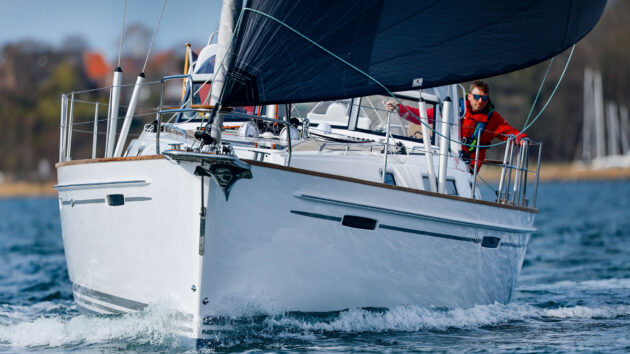
Visibility from the helm is very good, even with the spray-hood set from the targa arch. Photo: Paul Wyeth
Seeking the wind
Which brings me to the sailing. With the wind filling in and the cloud thinning, we slipped our box berth without touching a post thanks to the thrusters (proportional control and brushless motors makes them quiet and gentle at low speeds), taking any potential stress out of the manoeuvre. The 50hp Volvo engine gave a cruising speed of 7.2 knots and 8.2 at full chat (as well as driving the high-output Bamar secondary alternator).
We set the main and unfurled the code zero to ghost out past the harbour wall and into the bay, where a shifty but building breeze ruffled the carpet-flat water. As soon as we had space, we headed up to hunt for apparent wind.
With 5 knots of true wind, we were soon up over 5 knots, and 7-10 knots of wind saw us at 60º to the apparent, occasionally nudging over 8 knots. We reached backwards and forwards as the sky turned blue and the sun burst out. For proper downwind progress, we’d have needed to set an asymmetric spinnaker, though under the code zero, we still made 6 knots on a deep broad reach.
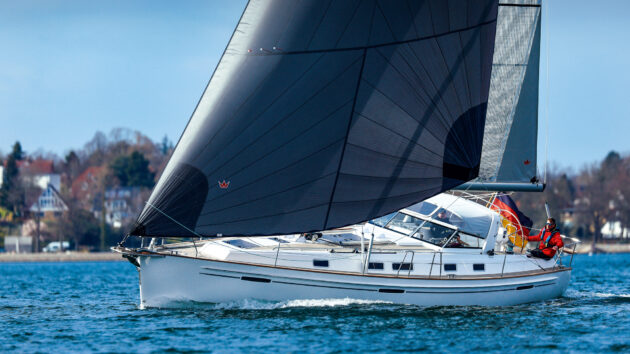
For a boat with a washing machine, the 41.2 picked up her heels easily. Photo: Paul Wyeth
Apparent magic
Heading back upwind is where the magic of this boat really becomes apparent. She’ll sail at almost hull speed in 5 knots of true breeze, and be fully up to speed in 7 knots, giving us 11-14 knots across the deck as we sliced upwind at up to 6.5 knots. Initially we made 30-35º to the apparent, but getting proper tension on the halyards and flattening the main a little saw us in the region of 27-30º.
The helm remains light and the boat was happiest at about 15º of heel, though she’ll continue to track straight and true as she heels. At 25º of heel, the helm starts to load up, talking to you about your sail trim, and while we didn’t have chance to see if there was a limit to her grip, she’ll talk to you about how things are feeling long before you get close to that.
What really struck me was the boat’s acceleration in every little gust, like a large touring car surging ahead in response to the accelerator, while she held her way in the lulls.
This is no twitchy race boat, but saving over half a tonne in her construction and a modest displacement of 9 tonnes means this is an exceptionally slippery and easily driven hull. All of which can be enjoyed from a comfortable and protected helming position. It only lacked foot-chocks for the helm, as these had yet to be added to fit her new owner precisely.
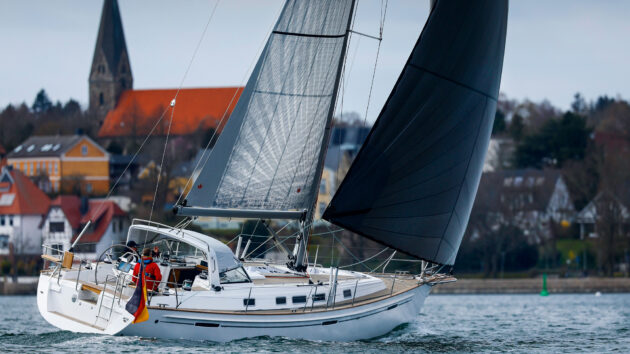
A permanently fitted ladder and bathing platform on the sugar scoop are good safety features and make boarding from a dinghy or the water easier. Photo: Paul Wyeth
Sail controls were easily to hand, with a pair of powered winches on each side just ahead of the helm, each dedicated to one sheet only, so there’s no faffing with switching between lines. The four-to-one German mainsheet was light enough to mostly control by hand.
Halyards are handled by a single powered winch under the sprayhood (the other is manual but can be used as a deflector), but a button on the helm console means that once you’ve loaded up the winch, you can step back to watch what you’re doing at the masthead.
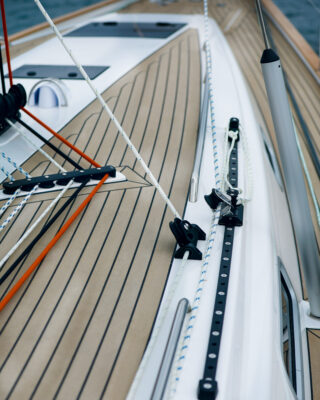
Grab rails extend all the way forwards, and inboard sheeting leads keep side decks clear. Photo: Paul Wyeth
Secure for sea
The targa arch from which the sprayhood sets also anchors the mainsheet; there’s no traveller (though it’s an option) but the height allows the boom to be centred easily without one. It’s a feature that contributes to the feeling of security in this deep cockpit, supported by a fixed glass windscreen, deep coamings and an enclosed transom.
Inside these lockers was a novel stowage for a hard valise liferaft, which is launched over the stern via curved rails when a toggle is pulled, popping a hatch in the transom open. Other stowage is plentiful, both in the lazarettes, in the sole-depth rope locker to port, the top access to the technical room to starboard, and the cavernous forepeak abaft the anchor locker.
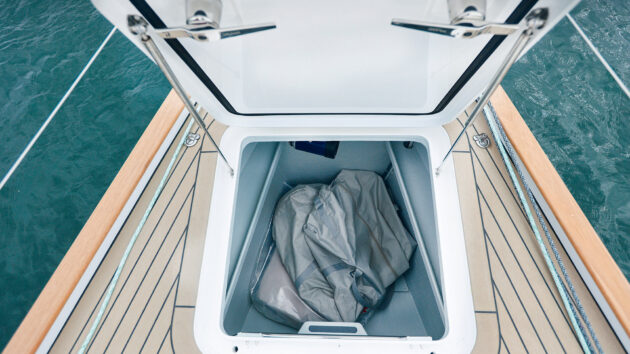
Offwind sails are swallowed by the forepeak. Note that hatch lids are moulded inside and out for a top notch finish. Photo: Paul Wyeth
On deck, moving about is aided by lots of handholds on the arch and windscreen, rails all the way to the forward end of coachroof, wide side decks inside teak-topped bulwarks, and inboard chainplates.
Coachroof-mounted jib tracks and below-deck furling help keep the decks clear. At the bow, an open pulpit and a stainless-and-wood bow platform houses the anchor and a folding ladder, making it easy to board your pride and joy via the bow.
Saare 41.2 specifications
Base Price: £461,739 ex VAT
LOA: 12.50m / 41ft 0in
LWL: 11.20m / 36ft 9in
Beam: 3.92m / 12ft 10in
Draught: 2.00m / 6ft 7in (1.80m / 5ft 11in)
Displacement: 9,300kg / 20,503 lbs
Ballast: 3,900kg / 8598 lbs
Sail area: 87.60m2 / 943 sq ft
Bal/disp ratio: 42%
Disp/length: 183.6
SA/D Ratio: 20.2
Engine Volvo: 50hp
Transmission: Saildrive
Water: 330L / 73 gal (+100L / 22 gal)
Fuel: 310L / 68 gal (+100L / 22 gal)
RCD Category: A
Designer: Karl-Johan Strählmann
Builder: Saare Yachts
Enjoyed reading this?
A subscription to Yachting Monthly magazine costs around 40% less than the cover price, so you can save money compared to buying single issues.
Print and digital editions are available through Magazines Direct – where you can also find the latest deals.
YM is packed with information to help you get the most from your time on the water.
-
-
- Take your seamanship to the next level with tips, advice and skills from our experts
- Impartial in-depth reviews of the latest yachts and equipment
- Cruising guides to help you reach those dream destinations
-
Follow us on Facebook, Twitter and Instagram.
Note: We may earn a commission when you buy through links on our site, at no extra cost to you. This doesn’t affect our editorial independence.
Verdict
Any number of Scandinavian yards promise serious cruising boats with decent performance and a high quality of finish. Some of these have embraced modernity with beamy hulls and twin rudders, some aim for the performance end of the market, while others have grown heavy with luxury. Somehow, the Saare 41.2 has sliced its way through the competition to deliver a boat that is at once light enough to be a delight to sail, solid enough to be reassuringly tough offshore, and one in which a couple could cruise indefinitely in absolute comfort. A combination of modern construction techniques, traditional craftsmanship, a ballast ratio of 42% and a generous 88m2 spread of canvas, produces a boat that, while conservatively understated in appearance, will take some beating on the water.

